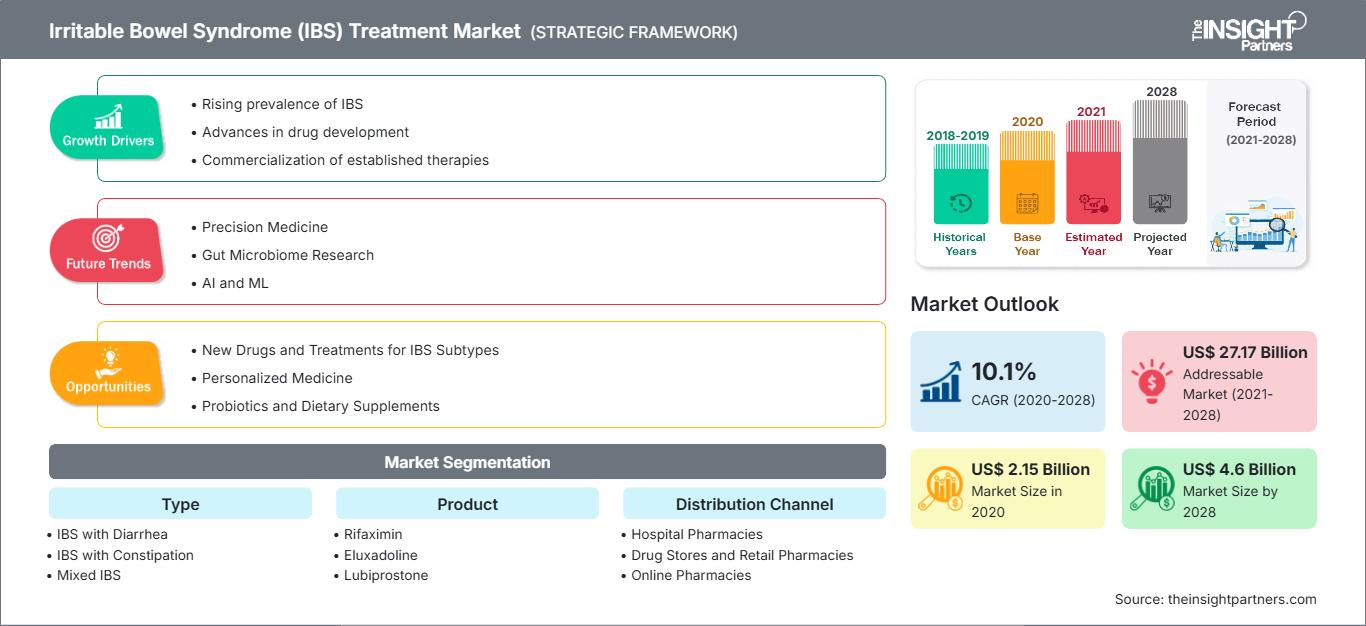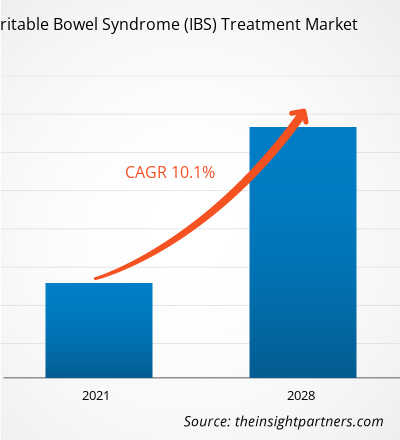過敏性腸症候群(IBS)治療市場は、2020年に21億5,389万米ドルと評価され、2028年までに46億30万米ドルに達すると予測されています。また、2021年から2028年にかけて10.1%のCAGRで成長すると見込まれています。
過敏性腸症候群疾患の罹患率の増加や研究開発活動の増加などの主な要因が市場の成長を牽引しています。ただし、製品の入手可能性が限られていることや治療の非効率性が市場の成長を抑制しています。IBSは、腹部臓器である大腸に影響を与える一般的な慢性疾患です。痙攣性大腸、粘液性大腸炎、過敏性大腸、痙攣性大腸炎とも呼ばれ、炎症性腸疾患とは大きく異なります。腹部のけいれん、腹痛、膨満感、ガス、下痢または便秘、あるいはその両方といった症状が現れます。軽度であれば、ストレス、生活習慣、食生活の改善で対処できます。一方、重度の場合は、薬物療法とカウンセリングで治療します。
アジア太平洋地域では、COVID-19を引き起こす新型コロナウイルスの蔓延を抑えるために、多くの対策が実施されています。これらの対策は、医療業界を含む様々な業界の多くの企業の業務に支障をきたしています。従業員の隔離、サプライチェーンの崩壊、需要の減少は、企業にとって深刻な問題を引き起こしています。また、民間病院チェーンでは、入院患者と外来患者の治療が大幅に減少しています。医療システムの負担を軽減するため、多くのクリニックが緊急性のない予約を延期しています。この状況は、過敏性腸症候群(IBS)治療の成長を妨げています。
要件に合わせてレポートをカスタマイズ
レポートの一部、国レベルの分析、Excelデータパックなどを含め、スタートアップ&大学向けに特別オファーや割引もご利用いただけます(無償)
過敏性腸症候群(IBS)治療市場: 戦略的洞察

-
このレポートの主要な市場動向を入手してください。この無料サンプルには、市場動向から見積もりや予測に至るまでのデータ分析が含まれます。
市場洞察
過敏性腸症候群および関連疾患の罹患率の増加
過敏性腸症候群は、排便習慣の乱れや腹痛によって引き起こされる、広くみられる慢性の胃腸疾患です。この疾患は、痙攣性大腸、過敏性大腸、粘液性大腸炎、痙攣性大腸炎とも呼ばれます。過敏性腸症候群は、腹痛、便秘、下痢、けいれんなどの症状を示します。地域全体の医療システムにおいて、過敏性腸症候群の発症率が著しく増加しています。国際消化器疾患財団が発表したデータによると、すべてのIBS患者のうち、約40%が軽度IBS、約35%が中等度IBS、推定25%が重度IBSに苦しんでいるとのこと。 多くの人はIBSの症状に気づいていません。
食物アレルギー、胃腸炎の進行段階、散発的な結腸運動、結腸内のセロトニンの異常な組成、軽度のセリアック病などの特定の要因は、IBSを引き起こす可能性のあるリスク要因です。 これらの要因により、世界中でIBSの有病率が加速すると予測されています。 たとえば、2018年にNCBIに発表された研究によると、IBSは毎年米国人口の約10%から16%に影響を与えると推定されています。 このようなIBSの驚異的な有病率は、予測期間中に過敏性腸症候群(IBS)治療市場を押し上げる可能性があります。
タイプ別インサイト
過敏性腸症候群(IBS)治療市場は、タイプ別に、混合型IBS(IBS-M)、下痢型IBS(IBS-D)、便秘型IBS(IBS-C)に分類されます。2020年には、混合型IBS(IBS-M)セグメントが市場で最大のシェアを占めました。また、同セグメントは予測期間中に最高のCAGRを記録すると予想されています。男女ともにIBSの有病率が上昇していることから、便秘と下痢の複合症状を治療できる医薬品の需要が高まると予想されます。特に、高齢者層ではIBSの有病率が高くなります。そのため、混合型IBS(過敏性腸症候群)治療薬の需要は、予測期間中に大幅に増加すると予想されます。
製品ベースの洞察
製品別に見ると、過敏性腸症候群(IBS)治療薬市場は、リファキシミン、エルクサドリン、ルビプロストン、リナクロチド、その他に分類されます。リナクロチドセグメントは2020年に最大の市場シェアを占めました。また、同セグメントは予測期間中、市場で最も高いCAGRを記録すると予測されています。このセグメントの市場成長は、リナクロチドのジェネリック医薬品の生産増加や、IBS治療薬としてのリナクロチドの開発・商品化に向けた市場統合の進展といった要因に起因しています。
流通チャネルに基づく洞察
流通チャネルに基づいて、過敏性腸症候群(IBS)治療市場は、病院薬局、ドラッグストアおよび小売薬局、オンライン薬局に分類されます。2020年には、病院薬局セグメントが市場で最大のシェアを占めました。しかし、予測期間中、ドラッグストアおよび小売薬局セグメントが最も高いCAGRを記録すると予想されています。
過敏性腸症候群(IBS)治療市場で事業を展開する企業は、世界中で変化する顧客の需要を満たすために製品イノベーション戦略を採用しており、これによりグローバル市場でブランド名を維持することも可能になっています。
過敏性腸症候群(IBS)治療市場の地域別分析
過敏性腸症候群(IBS)治療市場における予測期間全体にわたる地域的な動向と要因について、The Insight Partnersのアナリストが詳細に解説しています。本セクションでは、過敏性腸症候群(IBS)治療市場のセグメントと地域についても解説します。北米、ヨーロッパ、アジア太平洋、中東・アフリカ、中南米。
過敏性腸症候群(IBS)治療市場レポートの範囲
| レポート属性 | 詳細 |
|---|---|
| の市場規模 2020 | US$ 2.15 Billion |
| 市場規模別 2028 | US$ 4.6 Billion |
| 世界的なCAGR (2020 - 2028) | 10.1% |
| 過去データ | 2018-2019 |
| 予測期間 | 2021-2028 |
| 対象セグメント |
By タイプ
|
| 対象地域と国 |
北米
|
| 市場リーダーと主要企業の概要 |
|
過敏性腸症候群(IBS)治療市場のプレーヤー密度:ビジネスダイナミクスへの影響を理解する
過敏性腸症候群(IBS)治療市場は、消費者の嗜好の変化、技術の進歩、製品効果への認知度の向上といった要因によるエンドユーザーの需要増加に牽引され、急速に成長しています。需要の増加に伴い、企業は製品ラインナップの拡充、消費者ニーズへの対応のための革新、そして新たなトレンドの活用を進めており、これが市場の成長をさらに加速させています。

- 入手 過敏性腸症候群(IBS)治療市場 主要プレーヤーの概要
過敏性腸症候群 (IBS) 治療市場 – タイプ別
- 下痢性 IBS (IBS-D)
- 便秘性 IBS (IBS-C)
- 混合性 IBS (IBS-M)
過敏性腸症候群 (IBS) 治療市場 – 製品別
- リファキシミン
- エルクサドリン
- リナクロチド
- ルビプロストン
- その他
過敏性腸症候群 (IBS) 治療市場 –流通チャネル別
- 病院 薬局
- ドラッグストアおよび小売薬局
- オンライン薬局
過敏性腸症候群 (IBS) 治療市場–地理別
-
北アメリカ
- 米国
- カナダ
- メキシコ
-
ヨーロッパ
- フランス
- ドイツ
- イタリア
- 英国
- スペイン
- その他ヨーロッパ
-
アジア太平洋 (APAC)
- 中国
- インド
- 韓国
- 日本
- オーストラリア
- アジア太平洋地域のその他の地域
-
中東およびアフリカ (MEA)
- 南アフリカ
- サウジアラビア
- アラブ首長国連邦
- その他の地域MEA
-
南米および中米(SCAM)
- ブラジル
- アルゼンチン
- その他のSCAM
企業プロファイル
- Ironwood Pharmaceuticals, Inc.
- AbbVie.
- Sebela Pharmaceuticals, Inc.
- 武田薬品工業株式会社
- Alfasigma SpA
- Astellas Pharma Inc.
- AstraZeneca
- Synthetic Biologics, Inc.
- Bausch + Lomb Incorporated
- Lannett Company Inc
- 過去2年間の分析、基準年、CAGRによる予測(7年間)
- PEST分析とSWOT分析
- 市場規模価値/数量 - 世界、地域、国
- 業界と競争環境
- Excel データセット
最新レポート
お客様の声
購入理由
- 情報に基づいた意思決定
- 市場動向の理解
- 競合分析
- 顧客インサイト
- 市場予測
- リスク軽減
- 戦略計画
- 投資の正当性
- 新興市場の特定
- マーケティング戦略の強化
- 業務効率の向上
- 規制動向への対応






















 無料サンプルを入手 - 過敏性腸症候群(IBS)治療市場
無料サンプルを入手 - 過敏性腸症候群(IBS)治療市場